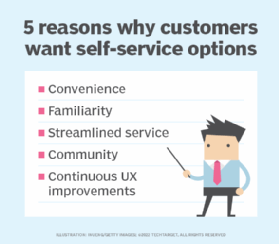
Fotolia
Why is customer self-service important for contact centers?
The advancement of conversational AI coupled with customers' growing desire for empowerment has made self-service channels critical for contact centers.
Over time, self-service has become a must-have for contact centers because it offers convenient service options that improve CX.
Although organizations traditionally perceived customer self-service as an opportunity to cut live agent costs, it also gives customers other communication channels they may prefer over phone-based communication. Self-service channels have become commonplace, and customers have grown increasingly accustomed to them. Also, self-service technology continues to advance, which makes it critical to any multichannel CX strategy.
Explore reasons why customers want self-service options, as well as the different types of self-service organizations can adopt.
Why do customers want self-service options?
Self-service lets customers resolve issues and find answers to questions without contacting a customer service agent, and this convenience has led organizations across industries to implement self-service options for their customers.
Key reasons that customers want self-service options include the following:
1. Self-service offers convenience. Store hours and traditional customer service channels, such as phone and email, can limit customer options. Self-service lets customers use FAQ pages, forums and virtual assistants to resolve issues on their own terms. These channels also let customers avoid long call hold times and potentially poor interactions with agents.
2. Customers feel comfortable with self-service. With the growth of e-commerce and mobile technology, self-service has become a part of everyday life. Apps and retailers that people use regularly, such as YouTube and Amazon, rely on self-service models. These services have required customer of all ages to grow comfortable with self-service. And since the start of the COVID-19 pandemic, organizations have increased their reliance on self-service because it doesn't require face-to-face interactions.

3. Self-service offers streamlined, automated processes. Automation technology, such as conversational AI, has improved over time. Conversational AI can let customers engage with interactive voice response systems through speaking, whereas simpler IVR systems make customers listen to a list of prompts and then decide which keypad numbers to press.
4. Self-service channels can foster community. Organizations can develop communities with forums and self-service on company websites. Customers may discover answers or receive help through interactions with other customers or community-designated subject matter experts. Customers can also access articles, video and other resources from peers in knowledge management systems.
5. Organizations have improved the self-service experience. Customers' frustrations with self-service, customer journey analysis and the broader use of CRM systems has led to self-service improvements. These improvements include simpler menu options and more relevant responses from IVR systems.
Types of customer self-service
Organizations can offer customers many different self-service channels. Common channels include FAQ pages, IVR systems, self-service portals and chatbots.
FAQ pages. This option is the simplest self-service channel. An FAQ page is often a search engine that taps into a knowledge base on a company website. Customers can manually scan a list of FAQs or enter search terms to find answers to their questions.
IVR systems. Simple IVR systems give callers options and ask them to press phone keys to learn information. For example, a bank's IVR system may prompt customers to press 1 to hear their account balance. IVR systems that use conversational AI may ask callers what they want -- for example, to make dinner reservations -- then route them to additional scripts to complete the reservations.
Self-service portals. After customers log into self-service portals, they can perform different functions, such as change their account address or view upcoming appointment dates. Portals can also let customers view pay stubs and medical records.
Chatbots. When customers visit an organization's website, chat windows often pop up. Customers can type questions into these chat windows, and the chatbots provide answers.
Due to technological improvements and customers' desire for empowerment, self-service has become a central part of multichannel customer service strategies.







